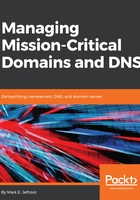
The registrant contact set
It cannot be overemphasized how important it is that your organization gets this part right, especially given how many times over the years I've seen companies get this part wrong, sometimes with catastrophic results. Any other mistake we can make when it comes to the administration of the registration details of our domain portfolio is fixable. Sometimes this one isn't. When that happens, it can result in a permanent "lock out" condition.
The listed registrant for a domain must be the legal name of your business, organization, or the ultimate user of the domain.
Too often, it is one of the following:
- An employee of the organization (using the employee's own name)
- An outside consultant
- "Fake" data of a nonexistent entity (in an effort to avoid spam or shield underlying data)
- The party who facilitated the domain registration (such as a web host or ISP) – "free domain included" offers are notorious for this
- The entity the domain was purchased from on the aftermarket whose contact details were never modified after control was transferred, which happens frequently
It's not completely clear whether domain names themselves are actual "property" or whether they simply convey rights. There have been arguments and legal decisions going both ways in differing jurisdictions. Suffice it to say for our purposes, the owner or rightsholder, whomever or whatever is listed as a domain's "registrant," is the ultimate authority over what happens to that domain.
This means that if you find yourself in a domain "lock-out" situation, the only entity that will be able to regain access and control over the domain is the one listed as the domain's registrant. If that is somebody else other than you, your company, or your organization, then you are at their mercy. If that somebody else doesn't exist, then you are probably screwed.